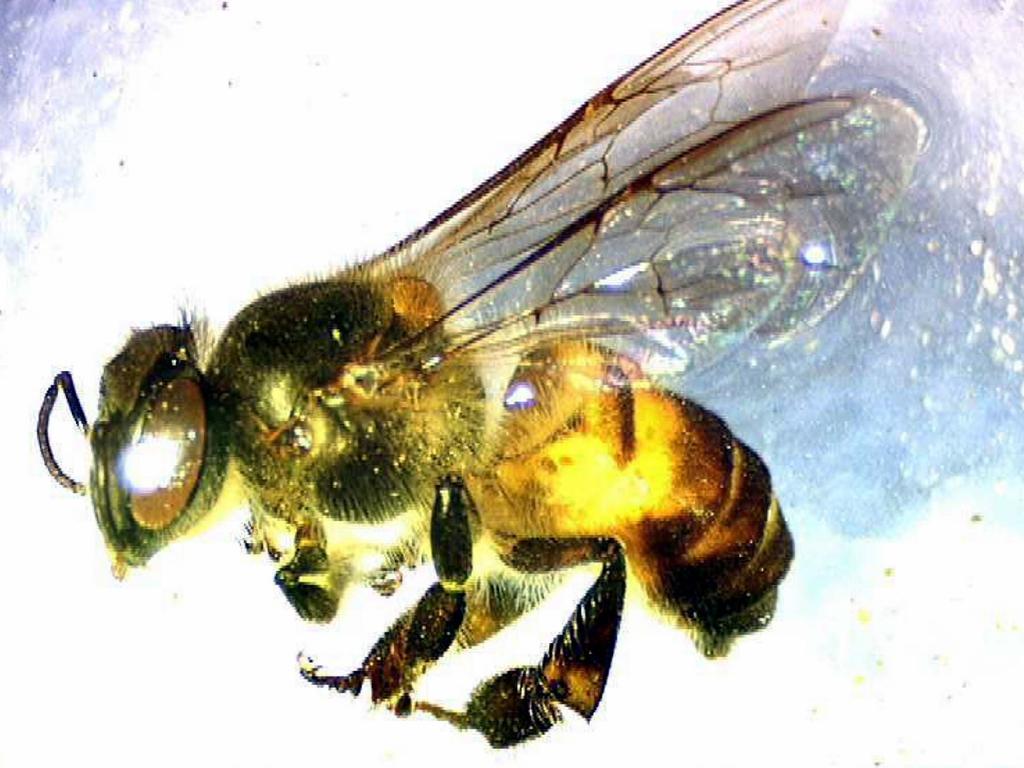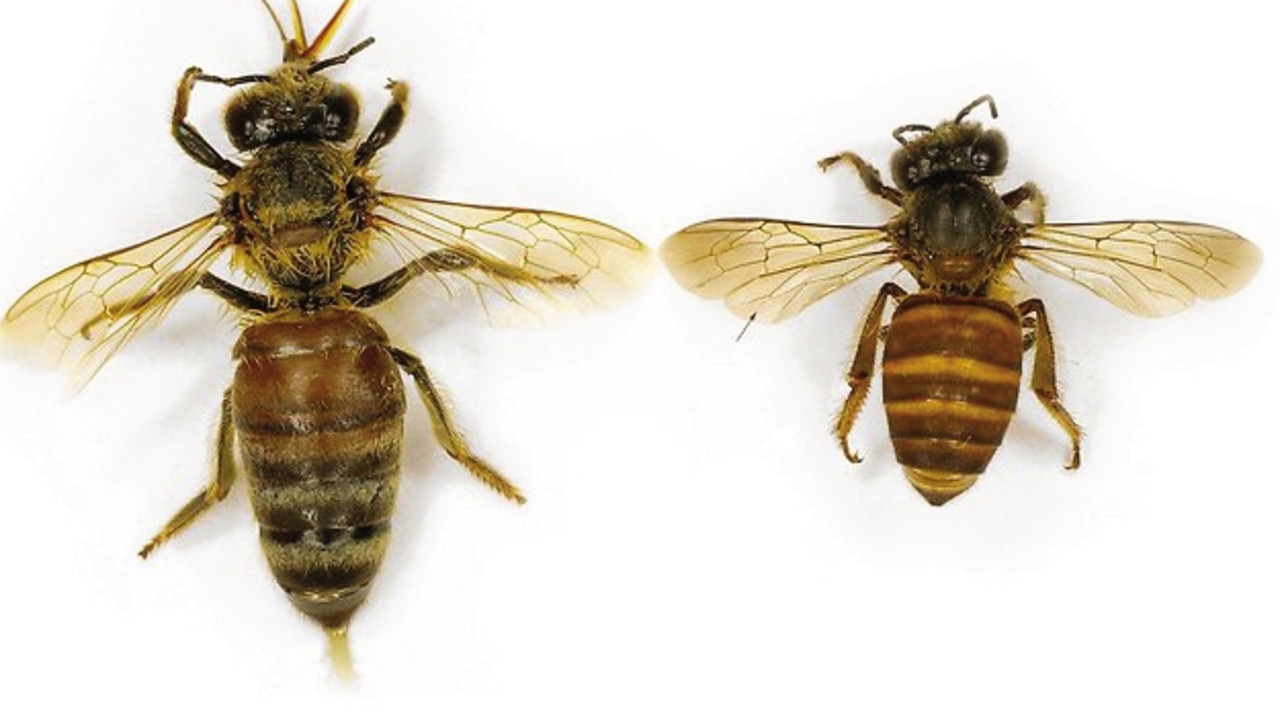Stowaway bee survival offers hope for threatened Australian species
World Bee Day 2024: How did a few stowaway bees stranded far from home survive life in a new country? The answer could bring fresh hope for Australia’s native bee population

READING LEVEL: ORANGE
As Kids News celebrates this year’s World Bee Day on May 20, the amazing survival story of an invasive bee species has given Australian scientists hope in the fight to protect native bee species currently under threat from land clearing.
STOWAWAY SURVIVORS
But we’re getting ahead ourselves – we need to go back in time to about 17 years ago, when a few Asian honey bees made their way to Australia for the first time, after a queen bee and her swarm managed to stow away on a ship from Papua New Guinea.

When the ship docked at a busy port in north Queensland, the queen and her swarm of Apis cerana flew to shore. Only a few of them survived – but that was enough. Despite the lack of genetic diversity that is usually needed for a strong colony, the species has since thrived in Australia.
Their survival has been called a “genetic bottleneck” by scientists puzzled by the ability of a species to shrink to small numbers before defying the odds to multiply and flourish.

NATURAL SELECTION
University of Sydney research fellow Dr Ros Gloag told ABC News in February that the bigger the population of bees, the better the chance that stronger, more adaptive genes will be passed on to the next generation to ensure the species’ survival – a process known as natural selection*.
“Having genetic diversity in a population is important,” Dr Gloag said.
“Because natural selection acts on the variation that’s within a population.”

Dr Gloag said in the same report the Asian honey bees’ survival in their new Aussie home showed that the population had adapted their foraging and reproductive behaviour on a genetic level – and that if they could do it, native Australian bees may be able to do it too. And that’s very good news.
WHY BEES ARE AT RISK
Australian native bee species have long been under threat from land clearing, with species such as the metallic carpenter bee and reed bees nesting in plants, and many stingless bees nesting in tree hollows. The use of pesticides at farms and home gardens has also led to the decline of our bees.

But while the survival of Asian honey bees in Australia has offered hope, it has also led to other bees becoming at risk. Considered a pest, the Asian honey bee is a threat to native Australian bees and to the European bees used to manufacture honey.
Dr Gloag told ABC News that different species can pass on disease and pests when they try to breed with one another.
One pest that could be carried between species is the deadly Varroa mite.

WHEN MITES ATTACK
European bees have long been relied upon to pollinate crops and make honey since they were introduced to Australia in the early 1820s, but populations have become at risk of being killed by the Varroa mite, a parasite that has been destroying bee colonies all over the world.
The mite made its way to Australia in 2022, prompting the government to destroy infected hives in an attempt to rid the country of the mite once and for all.

Unfortunately, the infestation was much larger than first thought and the government recently announced it wouldn’t be possible to stop its spread. Instead, scientists are now working to manage and minimise the spread.
More recently, another type of Varroa mite was discovered, the varroa jacobsoni mite, which is different to the varroa destructor that has been running rampant through Australian hives over the past two years. The varroa jacobsoni is often carried by Asian honey bees, but hasn’t posed as much a threat to European honey bees as the varroa destructor.

WHY BEES ARE SO IMPORTANT
Did you know that one out of every three mouthfuls of food you eat is because of the actions of bees?
According to the Wheen Bee Foundation, almost two-thirds of Australian food crops have depended on pollination by bees to get to our plates.
Almost 90 per cent of flowering plant species in Australia depend on bees for pollination. There are about 20,000 species of bees in the world, with about 2000 species of native bees in Australia. The extinction of our native bees could drastically change our ecosystem, leading to countless native plants becoming at risk of dying off and affecting animals that rely on their plants for food and shelter. Yes, bees sure are busy. And they need our help.

WORLD BEE DAY
Each year on May 20, Australia celebrates World Bee Day – an international day of awareness and education on the importance of bees for our survival and the wellbeing of the planet.
This year’s event will focus on the theme: Celebrating bees and their vital role in global food production systems.
Dozens of events will be held across the country, including the Great Bee Morning Tea, where schools, businesses and community groups will come together to share sweet treats made from Australian honey.

There’s also the Bring Your Buzz campaign on now until Sunday 26 May, where people are encouraged to wear yellow to their local farmers’ markets and buy food from bee-friendly farmers. The campaign was born from a partnership between the Wheen Bee Foundation and the Australian Farmers’ Markets Association.
“There are lots of ways to get involved, whether it’s joining a webinar, visiting a farmers’ market, taking part in a community gardening session, holding a pollinator picnic or simply talking to friends and family about the importance of bees,” Wheen Bee Foundation CEO Fiona Chambers said on World Bee Day’s official site.
Visit worldbeeday.org.au to find out how you can take part in the festivities to help Australian bees.
POLL
GLOSSARY
- genetic diversity: having a range of different genetic characteristics in the genes of a species
- adaptive genes: the ability for genes to mutate or change in order to help a species survive
- natural selection: the process through which species adapt to their environments in order to survive
- variation: change
EXTRA READING
Bees in ‘lockdown’ to stop parasite spread
How do bees make honey?
Plan to save Australian honey bees
QUICK QUIZ
1. How many species of bees are there in the world?
2. How many native species of bees are there in Australia?
3. What date is World Bee Day?
4. How many flowering plant species in Australia depend on bees for pollination?
5. Why are native and European honey bees at risk in Australia?
LISTEN TO THIS STORY
CLASSROOM ACTIVITIES
1. Expand your bee knowledge
Find out more about bees by researching one of the following:
- the life cycle of a bee
- the members of a bee colony
Draw a simple diagram and write a brief explanation about whichever topic you choose.
Time: allow 30 minutes to complete this activity
Curriculum Links: English; Science
2. Extension
Visit the World Bee Day website as suggested in the news story. Find the page that tells about actions that groups, individuals and farmers can take to help bees. Choose and write down in your own words three actions that are suitable and achievable for your family or class/school to do.
Time: allow 15 minutes to complete this activity
Curriculum Links: English; Science
VCOP ACTIVITY
Summarise the article
A summary can be a really good way to grab the main idea plus some key points in the article as a highlight. Think of the summary like a little advertisement or extract you could use to encourage people to read the article in detail. You want to give them an overview of the article that includes the main idea (being able to tell the audience what the article is about in one sentence), plus a few of the key points of the information.
Remember to re-read your summary to check that it is clear, concise and makes sense to the audience who haven’t read the article yet. You need to make language choices that allow you to explain the information in only a few sentences.

